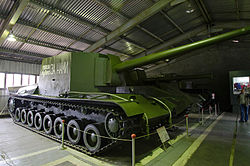This article needs additional citations for verification .(February 2009) |


Below is a list of tanks and other armoured fighting vehicles of the Russian empire, Soviet Union, the Russian Federation, and Ukraine .
Contents
- Imperial Russia, World War I
- Armored tractors
- Tanks
- Self-propelled guns
- After World War I to early World War II (1918-1940)
- Armored cars
- Tankettes
- Amphibious light tanks
- Light tanks
- Medium tanks
- Heavy tanks
- Tank destroyers and SPGs
- Flame-throwing tanks
- Other vehicles
- World War II (1941-1945)
- Armored cars 2
- Tankettes 2
- Light tanks 2
- Medium tanks 2
- Heavy tanks 2
- Tank destroyers and assault guns
- Self-propelled guns 2
- Self-propelled anti-air
- Lend-Lease tanks
- Captured tanks
- After World War II (Soviet era, continued)
- Armored fighting vehicles
- Light tanks 3
- Medium and main battle tanks
- Heavy tanks 3
- Tank destroyers and assault guns 2
- Self-propelled guns 3
- Self-propelled anti-air 2
- Tanks and AFVs with ATGMs
- Rocket launchers
- Flame-throwing tanks 2
- Laser tanks
- Other vehicles and AFVs
- Post-Soviet vehicles
- Armored fighting vehicles 2
- Light tanks 4
- Medium and main battle tanks 2
- Self-propelled guns 4
- See also
- References














